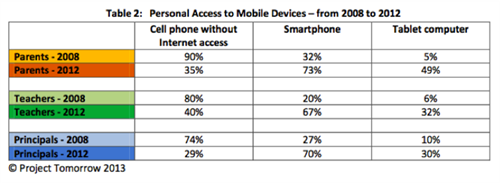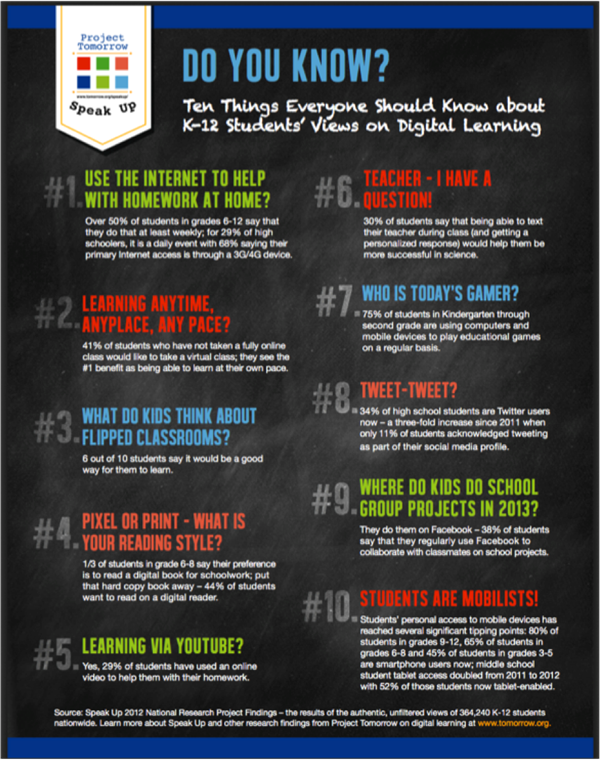- Coppell Independent School District
- Digital Use & Safety
- Devices in the Classroom
-
In January, Coppell ISD formed a Parent Advisory Group on Technology to meet and discuss topics that are of interest or concern to the community. One of the topics includes how CISD manages the different levels of distractibility that technology brings to the classroom.

Technology Infused Society
The world outside of school has already experienced a digital conversion, and it continues to change the way our culture (young and old) communicates, collaborates and connects.
Technology tools are vast and quickly evolving. Our younger learners have interacted with different technological tools (internet, tablets, smart phones with cameras) their whole lives, and our older learners embrace and conduct their lives using the latest digital devices. Even adults continue to adapt and utilize smart phones and tablets in their daily lives.
Multiple Devices
 Have you seen a young person with headphones on, typing on a laptop while also having a book open and their smart phone in hand? It may be hard to comprehend how they manage all those devices. Brain scientists have been looking at the brains of young people and have found that the Net-generation has developed a better “switching” ability with a better active memory. This means that, in many situations, learners can manage multiple inputs at the same time. This Net-generation not only switches their attention effortlessly between mediums, but they prefer to use multiple devices to accomplish different tasks.“We asked the students last year to identify for us their preferred device for a variety of academic tasks. The results pointed to a differentiation of devices that they wanted to use, based upon the inherent capabilities and roles of the devices. Create a presentation—kids want to use a laptop. Communicate or collaborate with peers—smart phone. Take notes in class—tablet. Read a book or article—digital reader.” –Speak Up 2012 National Findings
Have you seen a young person with headphones on, typing on a laptop while also having a book open and their smart phone in hand? It may be hard to comprehend how they manage all those devices. Brain scientists have been looking at the brains of young people and have found that the Net-generation has developed a better “switching” ability with a better active memory. This means that, in many situations, learners can manage multiple inputs at the same time. This Net-generation not only switches their attention effortlessly between mediums, but they prefer to use multiple devices to accomplish different tasks.“We asked the students last year to identify for us their preferred device for a variety of academic tasks. The results pointed to a differentiation of devices that they wanted to use, based upon the inherent capabilities and roles of the devices. Create a presentation—kids want to use a laptop. Communicate or collaborate with peers—smart phone. Take notes in class—tablet. Read a book or article—digital reader.” –Speak Up 2012 National Findings
It is very important that educators understand this new type of learner and embrace these devices, but it is equally as important that educators teach learners important skills about focus and how to successfully be in charge of their own learning. For example, these learners need to be able to identify times when they need to quiet those multiple inputs and concentrate on just one task. Coppell ISD supports environments like blended learning labs and reconfigured classrooms to allow learners to work independently while educators monitor learners and help them develop skills to stay on task. Learners must also hone their skills of scanning content and deciphering what pieces of information are important. They must also recognize when to slow down and digest content in-depth and in its entirety. These are all specific skills that the classroom teacher, integration specialists, librarians, and other staff teach learners throughout the year. (In upcoming communications, CISD will go more in-depth into how information literacy is taught at all levels.)
Device Management in the Classroom
Educators have been managing distractions in the classroom for a very long time, but CISD recognizes that iPads, laptops, smart phones, and e-readers have brought a different level of distraction to the classroom. As always, CISD is committed to working with educators on how to adjust teaching practices and classroom management to ensure a positive learning environment.
Technology is a tool. Like any tool, it needs to be monitored and learners need direction on expectations, consequences and how to use it in a productive way. Educators have realized that each type of technology (iPads, laptops, e-readers, etc.) provides different management challenges and thus requires different techniques. One common management technique used among educators is creating simple commands to communicate when it is time to transition to a low technology task.
Elementary educators say “apple-up” to their learners to indicate that it is time to stop using the iPad. 
Secondary educators say “three-fourths” meaning tilt the laptop screen down so it is only open one-forth of the way. CISD has ongoing professional development that supports educators in managing technology in the classroom and also helps educators modify and redefine their use of technology within a lesson. All secondary educators will be taking advantage of the professional learning day on February 17 to collaborate and learn best practices from each other in the areas of classroom management and technology integration. In addition, CISD has implemented an assessment tool, “SAMR,” that provides valuable feedback to educators about how technology is used in their lessons. (A deeper look into SAMR will come in the next technology communication.)“Managing a classroom of students with laptops is mostly about managing the students. This means you use the same tools for classroom management with laptops as you use for basic classroom management.” – Mike Haley, Tech & Learning
Technology is a powerful tool that gives learners the ability to search for knowledge, the platform to collaborate and communicate with others, and the means to generate their own content. Like any great tool, its use needs to be monitored and learners need direction on how to use it in a constructive way. Technology is powerful when used for best practices, but causes negative consequences when not monitored and used correctly. Coppell ISD is committed to safely and effectively integrating technology in the classroom and preparing learners with the 21st century skills they will need for their future.“Simply overlaying technology on to traditional teaching practices will have only a limited impact on learning. And sadly, the kids know this and see it every day. That’s why so many kids tell us each year that their frustration or disappointment with the use of technology at school is not about quantity, access, or quality—it’s about the unsophisticated use of the technology at their school. The kids know how they want to use these tools and how these tools can change the learning process, but … so many educators are either not thinking through the process or not up the task of transformation.” –eSN Special Report “Powering the Digital Classroom”


